The Camry, for Toyota's biggest company, has proven to be a landmark car. Today, there are more than 21 million examples of this model driving or standing around the world. At the end of the twentieth century, it became the most popular sedan in the USA, pushing the Ford Taurus off the pedestal, and it holds the first lines of sales in our country.

However, this sedan has its own mystery. Automobile historians argue how many generations it actually had. Somebody says ten. But if to take into account the first model that had a double name, it turns out that there were eleven. If we add absolutely different machines produced for the markets of the USA, Japan and Europe, then the whole 12 or even 14 generations. Let's take a look back at this car today and sort out this mystery together. My point of view may not coincide with yours. But I think my approach is correct.
So. At the very end of the seventies of the last century, the company Toyota, in order to diversify its lineup, as it is not easy to keep forty percent of the internal market, decided to launch a car based on units and aggregates of rather well-known Celica model as an experiment. But this car had a coupe body. It was necessary to increase a little bit a wheelbase and fill the car with a lot of additional equipment. The first Camry, released in 1980 (exactly 40 years ago) already had air conditioning and a lot of extras, which usually had to be paid for separately. It's impossible to say that the car was a success, that's why engineers took up designing of the next generation when they produced the first one. Why was it necessary to have a new platform? Simply donor, in this case Celica Camry, had drive on back wheels. And taking into account tendencies of the world market, Japanese had to make the car with front-wheel drive.
In 1982, fundamentally new car with factory name V10 was presented. But here also the Japanese have made a sly trick. The matter is that there are two models at once again built on the same platform. Toyota Vista and Camry. The pepper one flaunted a classical sedan body, and had no frames on windows. The Camry was available with classic doors, but the body kit was impressive. There was a sedan version, a liftback version and a station wagon.
At the very beginning of 1986, third generation Camry has appeared (well, we can consider it to be the car of generation two). It began to be produced not only in Japan, but also in the U.S. (America will subsequently become market number one for Toyota) and in Australia.
But with the fourth generation began to happen strange things. Cars for the domestic market differed from the export versions, not only in equipment, but also the body shape. For example, for the Japanese market, the company offered all-wheel drive chassis, and for export the trucks were more powerful, but simpler. Even the indexes of these trucks were different. The fourth generation was factory index V 30 and started production in 1990, and the fifth generation for the U.S. and Australian market had the index XV 10, and came to market a year later in 1991.
Further, there was more. In 1994, the sixth generation with index V40, which by its essence was nothing else but another variation on Vista theme, was presented in Japan. The sedan lost its all-wheel-drive chassis, but some models retained all-wheel drive.
At the same time, in 1996 an export version of the Camry XV 20 was introduced. It was luckier than others. The fact is that the car was sold all over the world. Only in Japan, it was called Gracia. And in the states, a very voluminous in size coupe Solara was presented.
The eighth generation XV 30 Camry was shown in 2001. By the way, it is the first model of this family officially presented on the market. And though now the platform for all models and markets became the same, nevertheless depending on region and preferences of customers the car came with different engines and different drive types. For example the Japanese did not have the most powerful engines, but it was possible to order a car with all-wheel drive. But Americans and What are the features of a Camry XV55? didn't have such an opportunity. Nevertheless, the car really took off. In both organisations and private individuals bought it. At a fairly modest price the new Camry attracted consumers with its low price and phenomenal reliability. That is what allowed it to surpass the main competitor Nissan Maxima.
2006 was the year of the appearance of the ninth generation XV 40. By the way, this car first received a registration, for the sake of cost optimization it began to be made in our country. And again the car became a bestseller. The reasonable price and rich equipment put it ahead of all the competitors. But again the markets were flooded with cars. Thus it was possible to order a car with all-wheel drive in Japan and a hybrid version in America. Toyota then began to actively promote exactly the environmentally friendly approach to the creation of models.

The XV 50 was the tenth generation of the car. It was unveiled in 2011. It was the last car in the Camry family that had different looks for different markets. The American model could be easily distinguished from the model for the Japanese market or for the market. It wasn't the steering wheel or the optics. They really did not resemble each other.
The eleventh generation was launched three years ago, in 2017, and its internal designation is XV 70. It's a fundamentally different car, it's built on the TNGA Group's new global platform. The crossover RAV 4 is based on this bogie from now on, and other models will be created on it in the near future.
But back to the families though. I believe, and as I think I believe quite rightly, that there are 11 generations of models produced over a long 40 years. Somebody considers, that there are 10, by the way why nobody takes into account the first car, appeared in 1980, I do not know. May be it's all about single platform? Well, the Camry shared it with other models later on as well. However, it's not important. Much more important is that this year the sedan celebrates exactly 40 years. With which I congratulate it.


-rear-and-front-view-camera-6.png)

